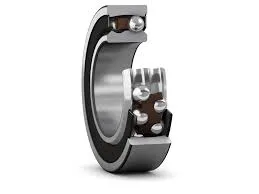
Oct . 17, 2024 13:29 Back to list
angular contact ball bearing drawing
Understanding Angular Contact Ball Bearings A Comprehensive Overview
Angular contact ball bearings are essential components in various mechanical systems, primarily designed to handle both radial and axial loads simultaneously. This unique capability makes them ideal for applications such as electric motors, gearboxes, and machine tools, where precision and efficiency are critical. In this article, we will delve into the design, functionality, and advantages of angular contact ball bearings while also highlighting key considerations when interpreting their technical drawings.
Design Features
Angular contact ball bearings consist of an inner race, outer race, and a series of precision-engineered balls that sit between these races. Unlike standard radial ball bearings, the races of angular contact bearings are inclined to each other, allowing them to support axial loads in one direction effectively. The angle of contact – typically ranging from 15 to 40 degrees – determines the bearing's load capacity and performance characteristics.
When examining an angular contact ball bearing drawing, several essential features must be noted
1. Raceway Profile The geometry of the raceways impacts the distribution of contact pressure and overall friction within the bearing. A proper design ensures that loads are evenly distributed among the balls, improving durability and efficiency.
2. Ball Size and Quantity The number and size of the balls influence the load-carrying capacity and the bearing's operational speed. Larger balls can carry heavier loads but may increase friction and reduce speed.
3. Clearance and Preload Preload is the axial load applied to the bearing during assembly to minimize play and improve stiffness. The drawings often specify the recommended preload levels, which are critical for operational stability and performance.
4. Sealing and Shielding To protect against contaminants and retain lubrication, angular contact bearings may feature seals or shields. These components are crucial for enhancing the life span of the bearing, especially in harsh environments.
angular contact ball bearing drawing

Functionality
The primary function of angular contact ball bearings is to facilitate smooth rotational movement while accommodating axial loads. This makes them particularly useful in applications where space is constrained and high performance is required. Consequently, these bearings are often found in high-speed machinery and equipment where precision engineering is paramount.
The angular contact design allows for load management in one primary direction while also stabilizing radial loads. For example, in a spindle application, angular contact bearings can effectively manage the forces exerted during operation, providing both speed and accuracy.
Advantages
Angular contact ball bearings offer numerous advantages
- High Load Capacity Their design allows them to handle higher axial and radial loads than typical ball bearings. - Increased Precision The ability to maintain tight tolerances contributes to improved overall precision in machinery. - Versatility They can be configured in pairs or sets to accommodate varying load conditions and orientations. - Durability With proper application, angular contact bearings exhibit excellent longevity and performance, reducing the need for frequent replacements.
Conclusion
The design and functionality of angular contact ball bearings are pivotal in many advanced mechanical systems. Understanding these bearings through their technical drawings is essential for engineers and designers aiming to optimize performance in their applications. By paying attention to key features such as raceway profiles, ball sizes, preload levels, and sealing mechanisms, one can effectively choose the right bearing type to enhance operational efficiency and reliability. Whether in aerospace, automotive, or industrial machinery, angular contact ball bearings continue to play a vital role in modern engineering solutions.
Latest news
-
Premium Deep Groove Ball Bearings | High Speed & Reliability
NewsAug.29,2025
-
Durable Scaffolding Clamps - Secure & Reliable Tube Connectors
NewsAug.28,2025
-
Common Failures in Thrust Ball Bearings and Solutions
NewsAug.22,2025
-
How Tapered Roller Bearings Can Take Shock Loads
NewsAug.22,2025
-
Angular Bearings in High-Precision Spindles
NewsAug.22,2025
-
The Impact of Misalignment on Cylindrical Roller Bearing Performance
NewsAug.22,2025
